In Python, how do I calcuate the peaks of a histogram?
I tried this:
import numpy as np
from scipy.signal import argrelextrema
data = [0, 1, 2, 3, 4, 0, 1, 2, 3, 4, 0, 1, 2, 3, 4, 1, 2, 3, 4,
5, 6, 7, 8, 9, 5, 6, 7, 8, 9, 5, 6, 7, 8, 9,
12,
15, 16, 17, 18, 19, 15, 16, 17, 18,
19, 20, 21, 22, 23, 24,]
h = np.histogram(data, bins=[0, 5, 10, 15, 20, 25])
hData = h[0]
peaks = argrelextrema(hData, np.greater)
But the result was:
(array([3]),)
I'd expect it to find the peaks in bin 0 and bin 3.
Note that the peaks span more than 1 bin. I don't want it to consider the peaks that span more than 1 column as additional peak.
I'm open to another way to get the peaks.
Note:
>>> h[0]
array([19, 15, 1, 10, 5])
>>>

